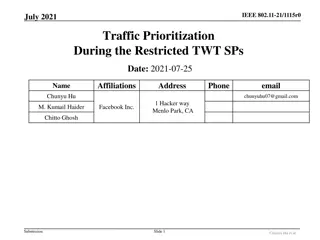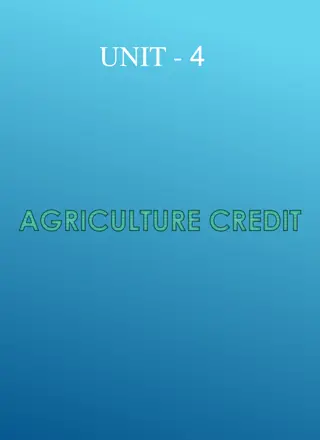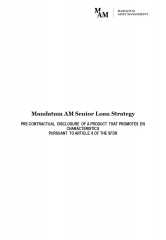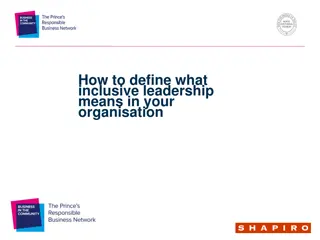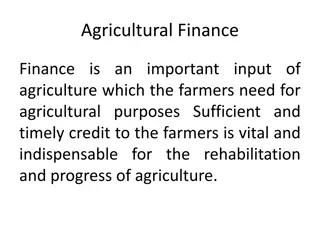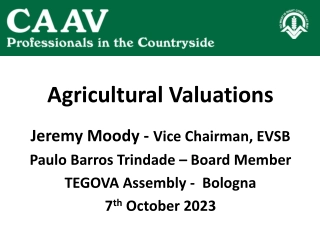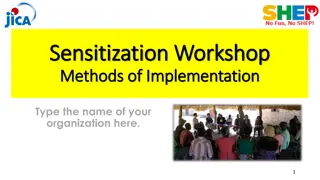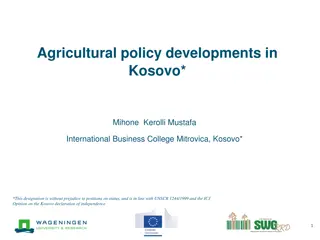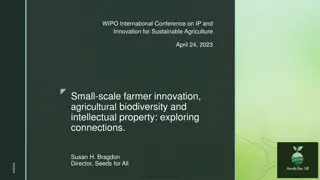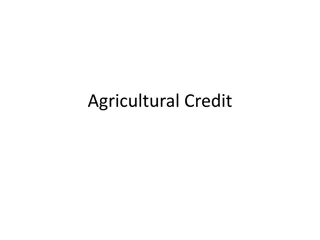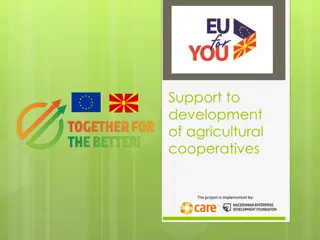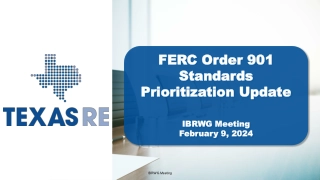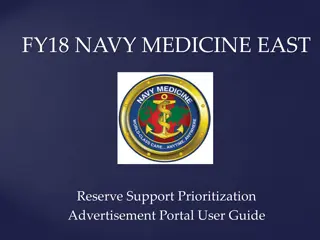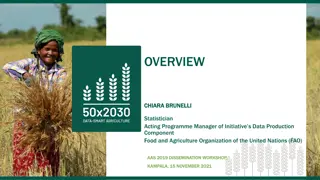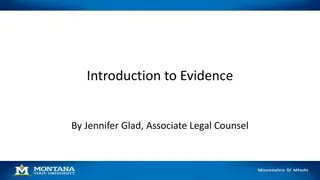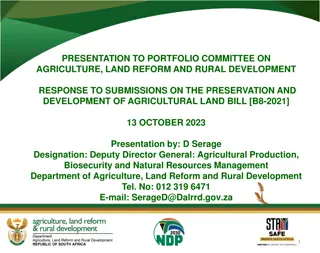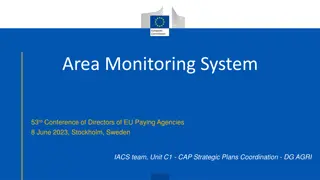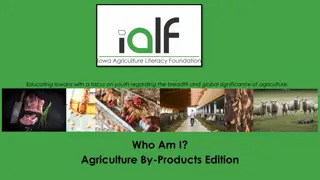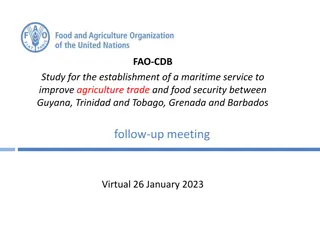Evidence-Based Public Investment Prioritization for Rwanda's Inclusive Agricultural Transformation
Explore the contributions of public spending on agriculture in Rwanda to economic growth, employment, poverty reduction, and diet quality improvements under the PSTA 4 allocations. Understand the impact of different types of investments on development outcomes, and identify opportunities for optimizing public spending to maximize impact. Utilize tools like the Rwanda CGE model and the 2017 SAM to analyze the food system's components, GDP share, and employment.
Download Presentation

Please find below an Image/Link to download the presentation.
The content on the website is provided AS IS for your information and personal use only. It may not be sold, licensed, or shared on other websites without obtaining consent from the author. Download presentation by click this link. If you encounter any issues during the download, it is possible that the publisher has removed the file from their server.
E N D
Presentation Transcript
Public Investment Prioritization for Rwandas Public Investment Prioritization for Rwanda s Inclusive Agricultural Transformation: Inclusive Agricultural Transformation: Evidence from Economywide Modeling Evidence from Economywide Modeling Emerta Aragie, Xinshen Diao, David J. Spielman, James Thurlow, Serge Mugabo, Gracie Rosenbach, and Gilberthe Benimana International Food Policy Research Institute May 27, 2022 Disclaimer Disclaimer: The analysis presented in this document is for discussion only and does not necessarily reflect the views of IFPRI or the Government of Rwanda. Full working paper:
Motivation Motivation 1. How much does public spending on agricultural contribute to economic growth, employment creation, poverty reduction, and diet quality improvements under the current PSTA 4 allocations (2018-2024)? 2. What are the contributions ofdifferent types of investmentto these development outcomes? 3. Is there room to improve the allocation of public spending under PSTA 4 so the same amount of spending can generate larger impacts on these outcomes? 4. If additional funds were made available to PSTA 4, where should these additional funds be allocated to maximize returns to these outcomes?
Context: Rwandas food system Context: Rwanda s food system Six components of the food system GDP Six components of the food system GDP Food system s share of national GDP Food system s share of national GDP and employment in Rwanda (2019) and employment in Rwanda (2019) 67% 67% Input supply (E) Hotels & food services (D) 35% 35% Trade & transport (C) 62% 62% Agro-processing (B) Primary agriculture (A) 26% 26% Food System GDP: Food System GDP: Total value added generated by all agricultural value chains Food System Employment: Food System Employment: Total number of workers who are primarily employed in an agricultural value chain GDP Employment
Tools and methods: The Rwanda CGE model & 2017 SAM Tools and methods: The Rwanda CGE model & 2017 SAM IFPRI s RIAPA IFPRI s RIAPA- -AIDA toolkit toolkit AIDA Firm Surveys Firm Surveys Household Surveys (EICV5) Household Surveys (EICV5) National Accounts National Accounts (NISR) (NISR) Rural Investment and Policy Analysis (RIAPA) model + Agricultural Investment Data Analysis (AIDA) module Social Social Accounting Accounting Matrix Matrix Balance of Balance of Payments (IMF) Payments (IMF) Micro Micro- - simulation simulation POV POV Poverty & Inequality RIAPA RIAPA AIDA AIDA WIST WIST DIET DIET Women s Inclusion Dietary Quality Government Financial Government Financial Statistics (MINECOFIN) Statistics (MINECOFIN) Investment Investment analysis analysis Public Agriculture Spending Public Agriculture Spending (MINAGRI, MAFAP) (MINAGRI, MAFAP) HDM HDM Livestock Herd Dynamics ASTI ASTI Agriculture Research Project M&E & Sector Studies Project M&E & Sector Studies Farm Surveys (EICV5, AHS, SAS) Farm Surveys (EICV5, AHS, SAS)
Analysis Analysis Part 1: Part 1: Estimate returns to individual policies, investments & expenditures to individual policies, investments & expenditures o Which interventions in PSTA 4 are more cost-effective in promoting an inclusive agricultural transformation? o What are the synergies and trade-offs in targeting different outcomes in the transformation process? Part 2: Determine a more efficient allocation through Part 2: Determine a more efficient allocation through marginal reallocation (budget rightsizing ) (budget rightsizing ) o How could reallocating scarce public resources improve development outcomes? Part 3: Determine the impact of a Part 3: Determine the impact of a budget increase under a more efficient allocation option allocation option o What are the impacts on development outcomes given an increase in budget that is allocated in a more efficient way? under a more efficient
Analytical procedure Analytical procedure Identify spending areas that relate directly to PSTA 4 that relate directly to PSTA 4priorities Focus on key crops/crop groups key crops/crop groups and key investments types key investments types Focus on synergies o E.g., input subsidies synergies between expenditures and investments expenditures and investments irrigation and terracing Measure marginal returns marginal returns to different expenditure options o The economic value of additional output created by each additional dollar spent Assess the gains to four specific development outcomes o Economic growth; employment creation; poverty reduction; diet quality improvement (see Annex for details ) development outcomes Simulate outcomes over a 15 o Costs and benefits are analyzed as cumulative outcomes over 15 years to capture both short-term impacts of spending and long-term impacts of investments a 15- -year period (2018 year period (2018- -2033) 2033)
Results are reported by sector and investment type for Results are reported by sector and investment type for the four development outcomes the four development outcomes Sectors Sectors 1. Maize 2. Rice 3. Irish potatoes 4. Beans 5. Soybean 6. Vegetables 7. Coffee & tea 8. Other cereals 9. Other RTBs Investments Investments 1. Small-scale irrigation 2. Marshland irrigation 3. Hillside irrigation 4. Progressive terracing 5. Radical terracing 6. Coffee & tea 7. Agriculture + livestock R&D 8. Non-agricultural investments 12. Other crops 13. Sugar 14. Livestock 15. Crop R&D 16. Livestock R&D 17. Electricity 18. Feeder roads 19. Education Development outcomes: Development outcomes: Economic growth, employment creation, poverty reduction, and diet quality improvements
Results: Part 1 Results: Part 1
Public spending on agriculture contributes substantially Public spending on agriculture contributes substantially to GDP growth to GDP growth GDP with and without $109 million in annual agricultural spending, 2018-24 (in constant (2017) US$ million) 12,450 Cumulative gains to GDP in 7 years: $1.57b in total GDP $1.17b from agriculture $0.18b from off-farm food system $0.22b from outside the food system $2.05 GDP per dollar spent 11,950 11,450 10,950 10,450 9,950 With agricultural spending 9,450 Without agricultural spending 8,950 8,450 2017 2018 2019 2020 2021 2022 2023 2024
Normalized outcome scores for public expenditures, by Normalized outcome scores for public expenditures, by sector, sector, based on based on development outcomes development outcomes Diet quality effect Poverty effect GDP effect Employment effect 0.16 1.00 1.00 Vegetables Livestock Other RTBs Maize Other crops Livestock R&D 1.00 1.00 0.73 0.45 0.95 0.07 0.28 0.39 0.84 0.14 0.09 0.31 0.57 0.09 0.04 0.08 0.37 0.05 0.42 0.22 0.51 0.34 0.29 0.45 Beans 0.46 0.20 0.02 0.29 Crops R&D Irish potatoes Electricity Feeder roads Coffee and tea Education Other cereals Soybeans 0.53 0.00 0.08 0.45 0.65 0.13 0.01 0.19 0.55 0.16 0.09 0.19 0.39 0.06 0.04 0.12 0.15 0.11 0.05 0.04 0.26 0.06 0.03 0.12 0.21 0.05 0.03 0.07 0.09 0.02 0.00 0.06 0.13 Rice 0.01 0.01 0.00 Sugarcane 0.00
Normalized outcome scores, by investment type, based on Normalized outcome scores, by investment type, based on development outcomes development outcomes Employment effect Diet quality effect GDP effect Poverty effect Small-scale irrigation 1.00 1.00 1.00 0.61 Radical terracing 0.19 0.44 0.87 1.00 Agricultural R&D 0.57 0.38 0.76 0.56 Nonagricultural 0.33 0.29 0.90 0.71 Livestock 0.70 0.32 0.67 0.47 Progressive terracing Marshland irrigation 0.54 0.27 0.79 0.52 0.14 0.07 0.23 0.16 Coffee and tea 0.00 0.00 0.00 0.50 Hillside irrigation 0.04 0.04 0.07 0.00
Expenditure rankings based on total contribution to development Expenditure rankings based on total contribution to development outcomes outcomes Ranking, by sector Ranking, by investment type Vegetables Coffee & tea Potato Crops R&D Livestock Livestock R&D Other crops Other rtbs Other cereals 0.89 Small-scale irri 0.90 0.69 0.42 Radical terrace 0.62 0.38 0.37 Agri R&D 0.57 0.36 Non-agri 0.36 0.56 0.36 Livestock 0.54 0.31 Beans 0.30 Progressive terrace 0.53 Soybeans Electricity Maize Feeder roads 0.26 0.25 Marshland irri 0.15 0.16 0.15 Coffee & tea 0.13 Rice 0.09 Education Sugar 0.08 Hillside irri 0.04 0.00 * Composite scores are based on their contribution to achieving the four focal development outcomes. Rankings are calculated based on an equally weighted average composite index for each of four development outcome indicators
Results: Part 2 Results: Part 2
Gains from spending under new and current allocation, 2018 Gains from spending under new and current allocation, 2018- - 2024 total, per dollar or per 1,000 dollar spent 2024 total, per dollar or per 1,000 dollar spent 6.0 0.0000 -0.0003 4.82 4.82 4.0 -0.1000 2.16 2.16 2.0 0.65 0.65 0.32 0.32 -0.2000 0.0 -0.3000 -2.0 -4.0 - -3.64 3.64 -0.4000 -6.0 -0.5000 -8.0 -0.5347 - -7.90 7.90 -0.6000 -10.0 New allocation Current allocation GDP (US$) Employed persons Number of the poor Diet quality index
Gains from reallocating current agricultural spending at the Gains from reallocating current agricultural spending at the margin to improve effectiveness of PSTA 4, 2018 margin to improve effectiveness of PSTA 4, 2018- -2024 2024 200 0 157 157 154 154 149 149 150 -0.002 100 -0.004 50 23 23 22 22 17 17 -0.006 0 -0.008 - -12 12 -50 -0.01 - -0.0101 0.0101 -100 -0.012 -150 - -0.0135 0.0135 - -0.0142 0.0142 -0.014 -200 - -210 210 - -222 222 -250 -0.016 Agiculture GDP or Rural Food system GDP or Urban GDP or National GDP Employment Poverty Diet quality index
Results: Part 3 Results: Part 3
What if What if an additional 5% p.a. was an additional 5% p.a. was efficiently allocated to public spending on agriculture? public spending on agriculture? allocated to Allocation of an additional $170m in PSTA 4 funding to match with agricultural growth in 2018-2024 (% of total) Additional spending allocation, by sector Additional spending allocation, by investment type 6.0% 1.1% 5.9% 10.0% 19.5% 6.7% 14.5% 2.1% 7.7% 10.1% 8.4% 3.9% 1.3% 26.3% 16.0% 8.9% 16.6% 2.8% Coffee and tea Irish potatoes Other cereals Other crops Maize Soybeans Other RTBs Livestock Rice Vegetables Beans Agiculture R&D Hillside irrigation Progressive terracing Nonagricultural Marshland irrigation Small-scale irrigation Radical terracing
Gains from an additional Gains from an additional $170m in public spending under a $170m in public spending under a new, more efficient allocation, 2018 new, more efficient allocation, 2018- -2024 totals 2024 totals 1,000 -0.0100 840 840 799 799 746 746 -0.0200 500 -0.0300 102 102 60 60 17 17 -0.0400 0 - -89 89 -0.0500 -500 -0.0600 -0.0700 - -0.0723 0.0723 -1,000 -0.0800 - -1,134 1,134 - -1,223 1,223 - -0.0855 0.0855 - -0.0884 0.0884 Agricultural or Rural -0.0900 -1,500 National Food System or Urban GDP (US$ million) Employed persons ('000) Number of the poor ('000) Diet quality index
Gains from an additional in public spending @ $35m (+5%) and Gains from an additional in public spending @ $35m (+5%) and $70m (+10%) in 2022 $70m (+10%) in 2022- -2024 under a new, more efficient allocation 2024 under a new, more efficient allocation 600 0.0000 378 378 354 354 400 332 332 300 300 289 289 272 272 -0.0100 200 45 45 35 35 26 26 21 21 9 9 8 8 0 -0.0200 -0.0204 - -30 30 - -33 33 -200 -0.0267 -0.0285 -0.0281 -0.0300 -0.0344 -400 -0.0357 - -406 406 - -436 436 - -494 494 - -527 527 -600 -0.0400 5% growth 10% growth 5% growth 10% growth 5% growth 10% growth National Food System or Urban Agricultural or Rural GDP (US$ million) Employed persons ('000) Number of the poor ('000) Diet quality index
Summary and conclusions (1) Summary and conclusions (1) Agricultural spending is, by and large, efficiently allocated in Rwanda: each dollar spent is associated with $2.05 gains in GDP Agricultural spending enables growth in employment opportunities outside of agriculture and in rural non-farm activities, paving a way for economic transformation Agricultural expenditures are poverty-reducing, and diet quality enhancing, especially among the rural households
Summary and conclusions (2) Summary and conclusions (2) No single expenditure option is the most effective in achieving all development outcomes economic growth, employment, poverty reduction, or diet quality improvement Expenditures and investments in high-value crops including vegetables, coffee & tea, and Irish potato would help achieve broad development outcomes faster Among investment types, small-scale irrigation ranks top in term of both cost- effectiveness and contribution to development outcomes Lower-cost approaches to costly investments such as hillside irrigation, marshland development, and progressive terracing can improve the contribution and impact of these investments
Summary and conclusions (3) Summary and conclusions (3) With a modest reallocation towards more efficient expenditures and investments, total GDP in 2018-2024 would be $154 million higher Additional gains can be achieved in employment, poverty reduction, and diet quality Findings justify an increase in the budget allocated to MINAGRI which has been stagnant (in constant prices) since PSTA 4 began in 2018 When additional public funds are allocated in favor of agricultural R&D, small-scale irrigation, and terracing, returns to outcomes would be higher Further improvements can be achieved with an increase in budget allocated to agriculture in an efficient manner Each additional $ spent generates $4.82 in GDP if allocated efficiently
Acknowledgements Acknowledgements




